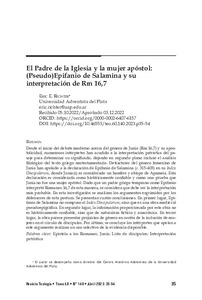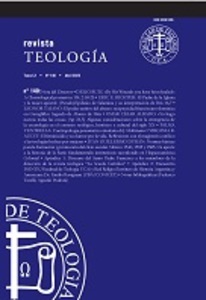Por favor, use este identificador para citar o enlazar este ítem:
https://repositorio.uca.edu.ar/handle/123456789/16217| Título: | El Padre de la Iglesia y la mujer apóstol : (Pseudo) Epifanio de Salamina y su interpretación de Rm 16,7 The father of the church and the woman apostle : (Pseudo) Epiphanius of Salamis and his interpretation of Rm 16,7 |
Autor: | Richter, Eric E. | Palabras clave: | INTERPRETACION; PADRES DE LA IGLESIA; CRISTIANISMO | Fecha de publicación: | 2023 | Editorial: | Pontificia Universidad Católica Argentina. Facultad de Teología | Cita: | Richter, E. E. El Padre de la Iglesia y la mujer apóstol : (Pseudo) Epifanio de Salamina y su interpretación de Rm 16,7 [en línea]. Teología. 2023, 60 (140). doi: 10.46553/teo.60.140.2023.p35-54. Disponible en: https://repositorio.uca.edu.ar/handle/123456789/16217 | Resumen: | Resumen: Desde el inicio del debate moderno acerca del género de Junia (Rm 16,7) y su apostolicidad,
numerosos intérpretes han acudido a la interpretación patrística del pasaje
para determinar su significado, dejando en segundo plano incluso el análisis
filológico del texto griego neotestamentario. Detractores del género femenino de
Junia han apelado a la declaración de Epifanio de Salamina (c. 315-403) en su Index
Discipulorum, donde Junia(s) es considerado un hombre y obispo de Apameia. Esta
declaración es considerada como históricamente confiable y como una prueba que
Junia no fue una mujer apóstol. Dado que un padre griego temprano como Epifanio
interpretó Romanos 16,7 de esta manera, se considera que debe ser la interpretación
más probable. En esta investigación se analizan los argumentos esgrimidos por los
defensores de esta postura. Se presentan cuatro conclusiones. En primer lugar, Epifanio
de Salamina no compuso el Index Discipulorum, sino que es una obra medieval
pseudoepigráfica. En segundo lugar, la información proporcionada por esta obra no
es históricamente confiable, sino que de naturaleza ficticia y anacrónica. En tercer
lugar, la obra parece presentar prejuicios de género en contra de la inclusión de mujeres
en el círculo de discípulos. Por último, se concluye los intérpretes que apelan a
este argumento realizan un uso selectivo de la evidencia disponible. Abstract: Since the beginning of the modern debate about the gender and apostolicity of Junia (Rm 16,7), numerous interpreters have resorted to the patristic interpretation of the passage to determine its meaning, leaving aside even the philological analysis of the New Testament Greek text. Detractors of Junia’s feminine gender have appealed to the statement of Epiphanius of Salamis (c. 315-403) in his Index Discipulorum, where Junia(s) is considered to be a man and Bishop of Apameia. This statement is regarded as historically reliable and proof that Junia was not a female apostle. Since an early Greek father like Epiphanius interpreted Romans 16,7 in this way, it is considered to be the most likely interpretation. This research analyzes the arguments put forward by the defenders of this position. Four conclusions are presented. In the first place, Epiphanius of Salamis is not the author the Index Discipulorum, but rather it is a medieval pseudo-epigraphical work. Second, the information provided by this work is not historically reliable, but rather fictitious and anachronistic in nature. Third, the work seems to present gender biases against the inclusion of women in the circle of disciples. Finally, it is concluded that the interpreters who appeal to this argument make a selective use of the available evidence. |
URI: | https://repositorio.uca.edu.ar/handle/123456789/16217 | ISSN: | 0328-1396 (impreso) 2683-7307 (online) |
Disciplina: | TEOLOGIA | DOI: | 10.46553/teo.60.140.2023.p35-54 | Derechos: | Acceso abierto | Fuente: | Teología. 2023, 60 (140) |
| Aparece en las colecciones: | TEO - 2023 Tomo LX nro. 140 |
Ficheros en este ítem:
| Fichero | Descripción | Tamaño | Formato | |
|---|---|---|---|---|
| padre-iglesia-mujer.pdf | 805,71 kB | Adobe PDF |  Visualizar/Abrir | |
| cover_issue_469_es_AR.jpg | 11,71 kB | JPEG |  Visualizar/Abrir |
Visualizaciones de página(s)
85
comprobado en 27-abr-2024
Descarga(s)
63
comprobado en 27-abr-2024
Google ScholarTM
Ver en Google Scholar
Altmetric
Altmetric
Este ítem está sujeto a una Licencia Creative Commons

